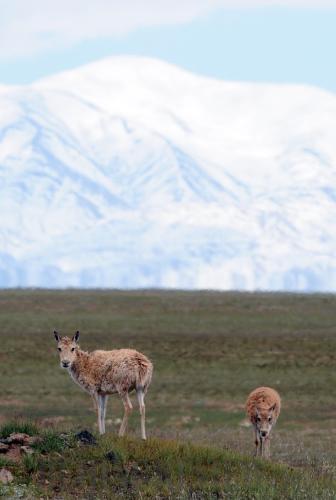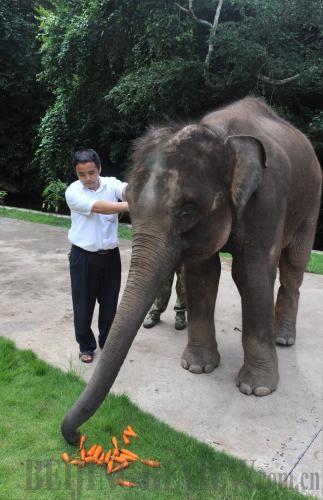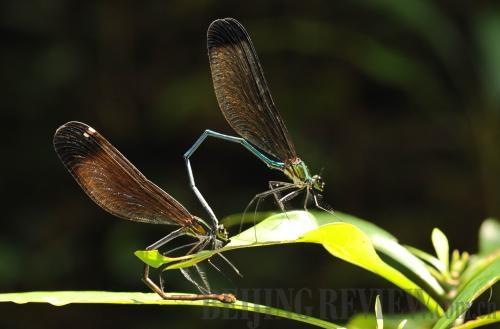(From Beijing Review, July 2010)
Of nearly 47,000 species that have been assessed by the GBO, 36 percent are endangered

FIGHTING EXTINCTION: Fifteen Thalasseus zimmermanni, known as "legendary birds" for their rareness, are seen in the Minjiang River estuary wetland, Fujian Province, in May 2009. Scientists estimate there are less than 50 types of birds in the world (XINHUA)
Greater numbers of species are disappearing from the planet. Biodiversity protection has become an urgent task for all of us. Given this, the UN declared 2010 the International Year of Biodiversity.
Chinese conservationists call for increased awareness of the importance of saving the biodiversity. The following are the perspectives of some Chinese scientists on the significance of, and measures for, biodiversity protection:
Lu Zhi (professor of conservation biology at the School of Life Sciences of Peking University):
Biodiversity is both universal and specific. Species you see in other places may also be found in the place where you live. But some of them can only survive in certain geological and climatic conditions.
The International Union for Conservation of Nature (IUCN) divides nature reserves into different types, which are national, co-management, private and community nature reserves. Of these, the community nature reserve is owned or managed by a community.
It is estimated there are about 28 million hectares of protected forest area around the world managed solely by communities, nearly 11 percent of the world's total forest area. Currently, community reserves are attracting greater attention and are considered one of the means of promoting aboriginal communities development and cultural identity.


HOME OF WILDLIFE: Two Tibetan antelopes walk on a pasture in the Hoh Xil National Nature Reserve on the Qinghai-Tibet Plateau (XINHUA)
PACHYDERM PRESERVE: A keeper feeds an elephant carrots at the Xishuangbanna Asian Elephant Breeding Center in Yunnan Province (XINHUA)
In some areas of China, once a unique tradition of nature conservation has been formed, it becomes a community reserve in reality, such as the "holy mountains and sacred lakes" in Tibet. These types of nature reserves are based on traditional cultures and religions. They demonstrate a combination of cultural values and natural values, and satisfy the communities' respect for the nature.
A survey conducted by the Department of Conservation Biology of Peking University shows in Ganzi Tibetan Autonomous Prefecture, Sichuan Province, there are 1,400 holy hills, covering an area of 5.1 million hectares, accounting for 33 percent of the prefecture's total land area.
The development of community nature reserves is not simply for conservation. Instead, it aims to let communities benefit from biological conservation based on sustainable use of local natural resources.
Take the Yunnan snub-nosed monkeys, one of China's starring species of conservation, for example. In order to protect the species, the local government invested a large amount of money in building two national and two provincial nature reserves to protect their habitats. Even so, the survey of Long Yongcheng, leader of a national expert group on primates, noted among the 13 groups of Yunnan snub-nosed monkeys surveyed, six remain outside the reserves, and two near the reserves.
It is worth noting community reserves have become key frontiers for the protection of the snub-nosed monkeys. Bamei Village in Deqin County of Yunnan Province is one of these reserves.
Bamei is located in Foshan Township, where Yunnan Province and Tibet Autonomous Region join. A survey in 2006 showed there were about 80 Yunnan snub-nosed monkeys in the mountains of Bamei, but the village was not covered by the established nature reserves. As a result, the local government and a number of nature conservation organizations jointly launched a special protection program. Through this program, the local government is striving to establish a community nature reserve in line with international practice, which will also provide opportunities for community development.

BEAUTIFUL COUPLE: A pair of damselflies linger on the leaves of plants in a forest in the Jiaxi Nature Reserve in Hainan Province (XINHUA)
Li Zhenji (professor at the School of Life Sciences of Xiamen University):
The Global Biodiversity Outlook (GBO), issued on May 10, 2010, by the UN Environment Program and the Secretariat of the Convention on Biological Diversity (CBD) concluded: The world did not realize biodiversity protection targets set in 2002, which means the world failed to effectively slow down the loss rate of biodiversity by 2010.
Biodiversity protection faces the unprecedented challenges, including non-mainstream threats. It is essential and urgent to coordinate protection goals and economic development strategy.
Since the CBD was signed by the UN Conference on Environment and Development in 1992 and the 2010 target of CBD was established in 2002, biodiversity protection has been highlighted within a certain range. A series of protection efforts have been carried out at national, regional and community levels and have made certain achievements.
For instance, the global reserve coverage reached 12.2 percent of the world land. More than 170 countries have formulated biodiversity protection action plans. Thirty-one bird species have been saved from extinction.
Nevertheless, with the increase in threats to biodiversity, more species are approaching extinction. Of nearly 47,000 species that have been assessed by the GBO, 36 percent are endangered.
What's more, threats to biodiversity, such as loss and degradation of ecological environment, climate change, excessive exploitation, unsustainable use and invasion of other species, are increasing.
The achievements of the past 20 or so years are only the victory in one of the battles of the biodiversity protection war, which is long-term and difficult. Human beings are still in extreme danger.
Protection has always been regarded as the duty of nature conservators, and its significance has not been completely accepted by the society. In other words, biodiversity protection is not yet a mainstream strategy of society. This is closely related to the less developed biodiversity protection science and economics.
It is estimated, of 5 million to 100 million species on the Earth, only about 2 million have been discovered, and those fully known by human beings are even less.
Due to lack of knowledge on biodiversity, construction projects damage the ecological environment frequently. Some wild species became extinct without leaving any trace.
In addition, the value of biodiversity is not rationally estimated. Take the value of a panda, for example. Different values are obtained from the assessments from different perspectives. Thus, it is not an easy task to estimate the value of a large ecosystem.
As the GBO pointed out, perception of the "critical point" of the ecosystem is the key to future biodiversity protection. In other words, we need to know in advance the degree of the impact biodiversity changes may bring to human beings, so as to take measures as early as possible.
The message delivered by the GBO is very disturbing. Indeed, the loss of biodiversity is causing disastrous results. But the situation is not hopeless. We should fully combine protection targets with economic development, so as to display biodiversity and ecological services' value to economy.
In addition, enterprises and individuals should be committed to slowing down the loss of biodiversity. Enterprises should start paying attention to their business' impact on biodiversity. The oil leak caused by British Petroleum's oil rig explosion in the Gulf of Mexico this April once again brought the disastrous result of enterprises' neglect of biodiversity protection into the spotlight.
Individuals should establish conservation awareness, reduce carbon footprints and purchase eco-friendly products to contribute to biodiversity protection.
Jin Jianming (academician of the Chinese Academy of Engineering, former Vice Minister of the State Environmental Protection Administration of China, now Ministry of Environmental Protection of China):
As one of the 12 countries with the world's most abundant biodiversity, China has every type of terrestrial ecosystems. It is one of the eight centers in the world where crops originated and one of the four originating centers of cultivated plants. Take crops alone for example. There are more than 600 varieties in China.
But species surveys show, in recent years, although the losses of some species have been reduced to a certain extent, the overall situation is still not effectively controlled. Species losses remain severe in China.
The construction of some projects presents challenges to the ecological environment. For instance, there are now only a few original natural forests in the Three Gorges reservoir area, and they are still decreasing.
Most forests in the area are secondary forests. A vast area of natural forests has gradually turned into grass, and finally becomes deserts. This has caused an imbalance of surface water resources and led to serious water pollution. It has also resulted in caved-in pits, ground fissures, dangerous rocks and collapses.
Meanwhile, because of geological movement, construction of the Three Gorges Project and destruction of forest vegetation, rare and endangered animals are distributed unevenly. Most are found in forests, grass and shrubs more than 800 meters above sea level, and are few in number and scattered.
Therefore, it is urgent to establish a science and technology innovation platform in Chongqing Municipality to deal with the threats to the ecological environment in the Three Gorges reservoir area. Through such a platform, a series of mechanisms could be established, such as a real-time monitoring of the environmental and ecological data of the local area.
The government should also research the feasibility of ecological migration in the area and bring forward implementation plans, in order to reduce the impact of human activities to the ecological environment of the reservoir area.
The heartening news is that China has established a national committee for the International Year of Biodiversity. At the same time, the Ministry of Environmental Protection of China will soon release a new version of the national strategy and action plan on biodiversity conservation, which will make clear China's strategic objectives for biodiversity conservation from 2010 to 2030, and confirm 30 areas that badly need protection.
Related News
Photos
More>>trade
- CAE President Zhou Ji Attended Serial Events Dedicated to Combining Efforts of
- The 2nd Meeting of The Operating Condition and Countermeasures of China s High
- CAE Vice President Xie Kechang Attended the 6th Annual Conference of Cross
- Fighting the Next Superbug
- The 2nd "China Rare Earth Industry Development Forum" Held in Baotou
market
- Honorary Chairman Xu Kuangdi Met with Press Group with China US Exchange
- CAE President Zhou Ji Met with IVA President Mr. Bjorn O. Nilsson
- CAE President Zhou Ji Met with INAE President, Dr. Prem Goel
- Enlarged Meeting for CAE Environment and Textile Engineering Academic Division
- China, Sweden Vow to Enhance Cooperation in Engineering Sciences
finance
- CAE President Zhou Ji Signed Agreements with Xinjiang Autonomous Region for
- The 2nd Session of the Fifth Governing Board Held in Nanjing
- A Double Blessing Descended upon CAE Member Yuan Longping First Hybrid Rice
- Both CAE and CAS Member Wang Dianzuo Won Lifetime Achievement Award at IMPC 2010
- CAE Member Xiang Haifan Won ASCE Robert H. Scanlan Medal





